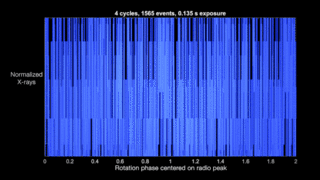Apr 9 2021
X-ray surges that accompany radio bursts from the pulsar in the Crab Nebula have been discovered by a universal science collaboration with the help of data from NASA’s Neutron star Interior Composition Explorer (NICER) telescope on the International Space Station.

Image Credit: NASA’s Goddard Space Flight Center/Enoto et al., 2021.
The study results demonstrate that such bursts, known as giant radio pulses, discharge much greater energy compared to what was speculated earlier.
A pulsar is a kind of quickly spinning neutron star, the crushed, city-sized core of a star that burst as a supernova.
A young, individual neutron star has the ability to spin dozens of times every second, and its whirling magnetic field powers beams of radio waves, X-rays, gamma rays and visible light. If such beams sweep past Earth, astronomers note clock-like pulses of emission and categorize the object as a pulsar.
Out of more than 2,800 pulsars cataloged, the Crab pulsar is one of only a few that emit giant radio pulses, which occur sporadically and can be hundreds to thousands of times brighter than the regular pulses. After decades of observations, only the Crab has been shown to enhance its giant radio pulses with emission from other parts of the spectrum.
Teruaki Enoto, Lead Scientist, RIKEN Cluster for Pioneering Research
As part of the new study, which is currently available online and will be published in the April 9th edition of the journal Science, researchers have examined the biggest amount of concurrent X-ray and radio data gathered from a pulsar. It expands the noted energy range linked with this improvement phenomenon by thousands of times.
Being situated around 6,500 light-years away in the Taurus constellation, the Crab Nebula and its pulsar were produced by a supernova whose light reached Earth in July 1054. The neutron star spins around 30 times every second, and it is one of the brightest pulsars in the sky at X-ray and radio wavelengths.
From August 2017 and August 2019, Enoto and his team employed NICER to continuously visualize the Crab pulsar in X-rays with energies ranging up to 10,000 eV, or thousands of times that of visible light.
While NICER was performing the observations, the researchers also analyzed the object with the help of at least one of two ground-based radio telescopes in Japan—the 64-m dish at the Japan Aerospace Exploration Agency’s Usuda Deep Space Center and the 34-m dish at the Kashima Space Technology Center, both functioning at a frequency of 2 GHz.
The integrated dataset effectively offered the team almost a day and a half of concurrent X-ray and radio coverage. Altogether, they captured activity throughout 3.7 million pulsar rotations and captured nearly 26,000 giant radio pulses.
Giant pulses tend to explode rapidly, rising in millionths of a second, and happen all of a sudden. But when they emerge, they coincide with the normal clockwork pulsations.
NICER registers the arrival time of each X-ray detected by it within 100 ns, but the timing accuracy of the telescope is not its only benefit for this study.
NICER’s capacity for observing bright X-ray sources is nearly four times greater than the combined brightness of both the pulsar and its nebula. So these observations were largely unaffected by pileup—where a detector counts two or more X-rays as a single event—and other issues that have complicated earlier analyses.
Zaven Arzoumanian, Project Science Lead, Goddard Space Flight Center, NASA
The research team of Enoto integrated all of the X-ray data that corresponded with giant radio pulses, thereby finding an X-ray boost of around 4% that happened synchronously with them.
It is quite similar to the 3% increase in visible light also connected with the phenomenon, unraveled in 2003. By contrast to the variation in brightness between the Crab’s normal and giant pulses, such variations are remarkably small and thus are difficult for theoretical models to explain.
The improvements signify that giant pulses are an indication of fundamental processes that generate emission spanning the electromagnetic spectrum, from radio to X-rays. Due to the fact that X-rays pack millions of times the punch of radio waves, even a small increase constitutes a huge energy contribution.
The team concludes that the entire emitted energy related to a giant pulse is dozens to hundreds of times greater than estimated earlier using the radio and optical data only.
We still don’t understand how or where pulsars produce their complex and wide-ranging emission, and it’s gratifying to have contributed another piece to the multiwavelength puzzle of these fascinating objects.
Teruaki Enoto, Lead Scientist, RIKEN Cluster for Pioneering Research
NASA’s NICER Finds X-ray Boosts in the Crab Pulsar’s Radio Bursts
Observations from NASA’s Neutron star Interior Composition Explorer (NICER) show X-ray boosts linked in the Crab pulsar’s random giant radio pulses. Video Credit: NASA’s Goddard Space Flight Center
Journal Reference:
Enoto, T., et al. (2021) Enhanced x-ray emission coinciding with giant radio pulses from the Crab Pulsar. Science. doi.org/10.1126/science.abd4659.